절삭 공구에 관해서는 텅스텐 카바이드와 고속도강(HSS)이라는 두 가지 소재가 계속해서 언급됩니다.
어느 것이 자신의 업무에 더 적합한지 궁금하다면 답은 속도, 내구성, 예산 중 무엇을 더 중요하게 생각하는지에 따라 달라집니다.
하지만 오래가는 도구, 더 나은 성능, 더 빠른 가공을 원한다면 텅스텐 카바이드가 확실한 승자입니다.
이 가이드에서는 모든 내용을 쉽게 설명해 드리겠습니다. 텅스텐 카바이드와 HSS의 차이점, 각 소재의 사용 시기, 그리고 대부분의 최신 용도에 카바이드 절삭 공구가 더 적합한 이유를 알아보세요.
1. 고속도강(HSS)이란?
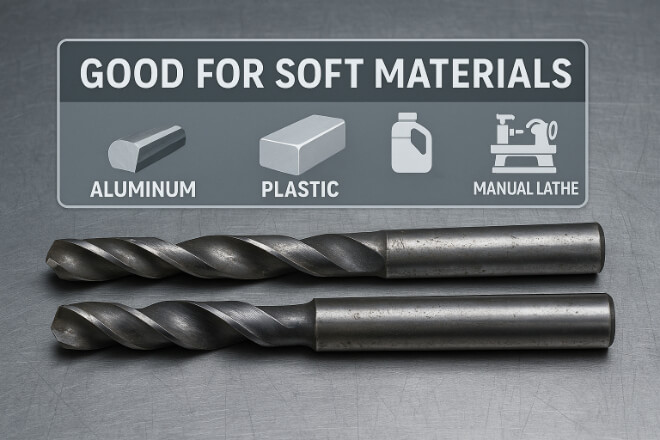
고속도강은 수십 년 동안 절삭 공구에 사용되어 온 경화강의 한 종류입니다. 견고하고 저렴하며 날을 세우기 쉬운 것으로 알려져 있습니다.
HSS 도구는 다음과 같은 부드러운 재료에서 중간 정도의 재료를 절단할 때 가장 효과적입니다.
알류미늄
연강
플라스틱
목재
이러한 장치는 수동 공구, 드릴 비트, 저속 기계에서 흔히 사용됩니다.
HSS의 장점:
더 낮은 가격
재분쇄나 재성형이 용이함
튼튼함(깨지기 쉬움)
하지만 HSS 공구는 특히 고속 절삭이나 단단한 금속 절삭 시 날카로움이 빠르게 떨어집니다. 또한 초경 공구만큼 열에 강하지 않습니다.
2. 텅스텐 카바이드란 무엇인가요?
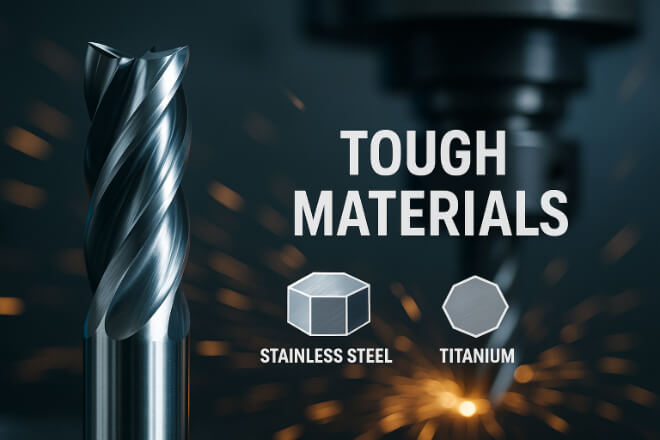
텅스텐 카바이드는 텅스텐과 탄소 분말을 결합하여 만든 매우 단단한 소재입니다. HSS보다 훨씬 단단하고 날카로운 날을 훨씬 오래 유지합니다.
초경 공구는 다음 분야에서 널리 사용됩니다.
CNC 가공
고속 밀링
정밀 드릴링
견고한 소재(스테인리스강, 티타늄, 주철 등) 절단
의 이점 텅스텐 카바이드 절단 도구:
더 오래 날카로움을 유지하세요
더 나은 정확도로 더 빠르게 절단하세요
열을 잘 견디고 착용감이 좋습니다
단단하거나 연마성이 있는 재료에 적합합니다.
초경 공구는 초기 비용이 더 많이 들지만, 수명이 더 길고 더 나은 결과를 제공합니다. 특히 대량 작업이나 정밀 작업에서 그렇습니다.
3. 주요 차이점: 텅스텐 카바이드와 고속도강
| 특징 | 텅스텐 카바이드 | 고속도강 |
|---|---|---|
| 경도 | 매우 높음 - 더 오래 날카로움이 유지됩니다 | 중간 - 더 빨리 둔화됨 |
| 내열성 | 훌륭한 | 좋은 |
| 절삭 속도 | 매우 빠르다 | 더 느리게 |
| 공구 수명 | 5~10배 더 길다 | 더 짧은 |
| 엣지 강도 | 매우 날카롭지만 더 부서지기 쉽습니다. | 더 튼튼하고 구부릴 수 있습니다 |
| 비용 | 더 높은 선불 | 앞쪽 낮은 |
| 최상의 사용 | 경질소재, CNC, 생산 | 연성 금속, 가벼운 작업, 수동 도구 |
4. 텅스텐 카바이드가 (대부분의 작업에) 더 나은 이유
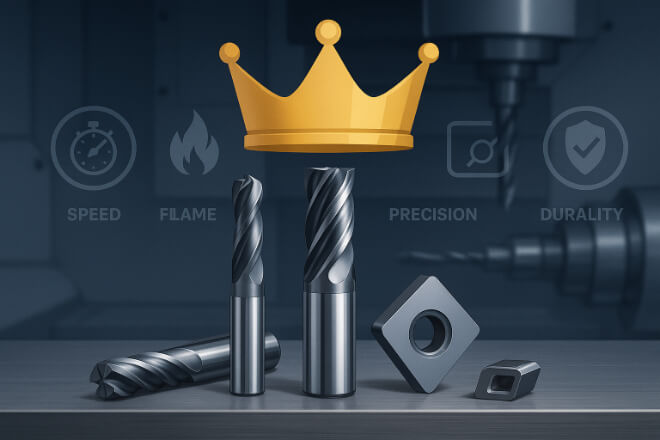
1). 훨씬 더 오래 지속됩니다
초경 공구는 HSS 공구보다 훨씬 오래갑니다. 보통 5~10배 더 깁니다. 즉, 공구 교체 횟수, 가동 중단 시간, 교체 횟수가 줄어듭니다.
2). 더 빠른 절단
텅스텐 카바이드 공구는 높은 경도와 내열성 덕분에 훨씬 빠른 절삭이 가능합니다. 특히 CNC 기계에서 더 짧은 시간에 더 많은 작업을 처리할 수 있습니다.
3). 열을 더 잘 처리합니다
열은 공구 마모의 주요 원인입니다. 초경은 고온에서도 강도를 유지하므로 건식 절삭이나 고속 가공에서 더 우수한 성능을 발휘합니다.
4). 단단한 재료에 더 좋습니다
스테인리스 스틸, 티타늄, 경화 합금 등은 HSS 공구를 빠르게 마모시키는 질긴 소재입니다. 초경합금은 이러한 작업에 적합합니다.
5). 더 깨끗한 마무리
초경 공구는 더 매끄러운 표면과 더 정확한 절단을 가능하게 합니다. 이는 정밀한 공차나 광택 마감이 필요할 때 중요합니다.
6). 더 효율적
네, 초경 공구는 가격이 더 비싸지만, 시간이 지남에 따라 비용을 절감할 수 있습니다. 더 긴 수명, 더 나은 성능, 그리고 더 적은 공구 교체로 부품당 총 비용이 절감됩니다.
5. 고속강이 여전히 의미가 있는 경우
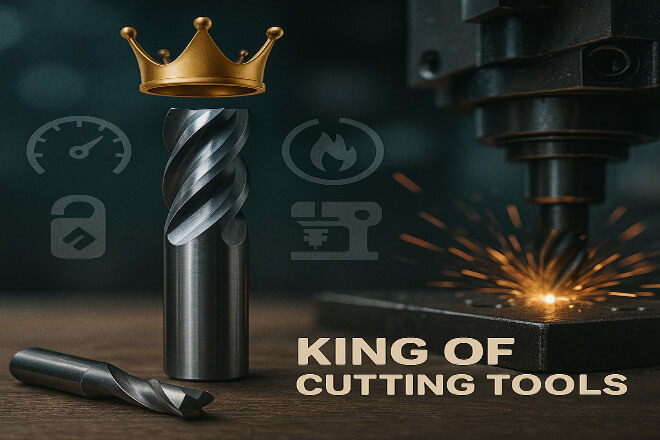
공평하게 말하면, HSS가 전혀 쓸모없는 것은 아닙니다. 특히 다음과 같은 특정 직업에서는 여전히 가치가 있습니다.
예산이 부족해요
연성 금속 절단
수동 기계 사용
도구는 자주 다시 날을 세웁니다
소량 또는 일회성 작업
플라스틱, 알루미늄 또는 목재를 절단하는 경우나 고속 절단이 필요하지 않은 경우 HSS가 충분할 수 있습니다.
하지만 대부분의 생산 환경에서는 카바이드가 더 나은 성능을 발휘합니다.
6. 실제 사용 사례
| 애플리케이션 | 최고의 도구 | 왜 |
|---|---|---|
| CNC 가공 | 텅스텐 카바이드 | 빠른 속도, 긴 수명, 엄격한 허용 오차 |
| 스테인리스 스틸 절단 | 텅스텐 카바이드 | 열과 마모에 강함 |
| 알루미늄 수동 선반 | HSS | 비용이 저렴하고 재분쇄가 용이함 |
| 항공우주 부품 | 텅스텐 카바이드 | 티타늄 및 정밀 부품에 필요 |
| DIY 워크숍 | HSS | 가끔 사용하기에 저렴함 |
7. 흔한 오해(폭로)
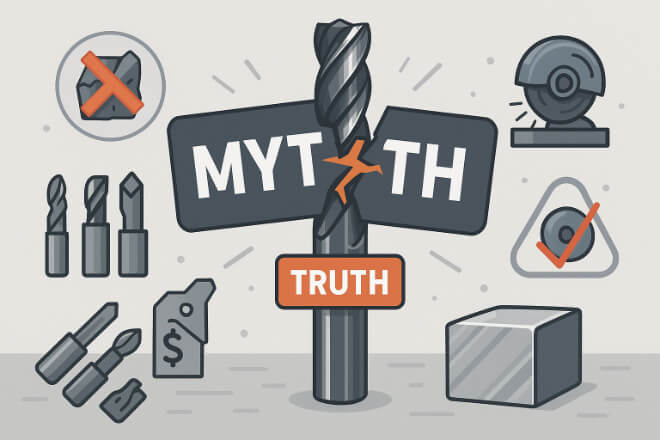
오해 1: 카바이드는 너무 쉽게 부서진다.
사실이 아닙니다. 최신 초경재는 그 어느 때보다 더 견고하고 신뢰성이 뛰어납니다. 제대로 사용하면 힘든 작업에서도 잘 견딥니다.
오해 2: HSS는 날을 세우면 똑같이 좋다.
날을 세우는 것이 도움이 되지만, HSS가 더 빨리 마모되고 더 느리게 절단한다는 사실은 변하지 않습니다.
오해 3: 카바이드는 대형 작업장에만 사용된다.
이 또한 거짓입니다. 많은 중소 규모 작업장에서는 초경 공구를 사용합니다. 시간이 지날수록 가치가 더 좋기 때문입니다.
최종 판결: 카바이드가 승리
그렇다면 텅스텐 카바이드와 고속도강 중 어떤 절삭 공구가 더 나을까요?
당신이 원하는 경우:
더 긴 공구 수명
더 빠른 가공
더 나은 표면 마감
장기적으로 더 낮은 비용
경질 재료에서의 고성능
그렇다면 텅스텐 카바이드가 분명히 더 나은 선택입니다.
고속도강은 특히 부드러운 소재를 절단하거나 손으로 작업할 때 여전히 어떤 경우에는 효과적입니다.
하지만 본격적인 기계 가공, 특히 CNC 가공의 경우 초경 공구는 거의 모든 면에서 HSS보다 성능이 뛰어납니다.
기계에 맞는 공구를 선택하는 데 도움이 필요하신가요? 문의하세요. 다시 올리기 전문가의 지도나 맞춤형 카바이드 솔루션이 필요합니다.
